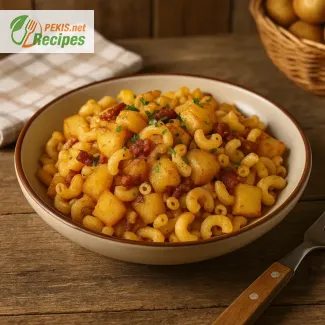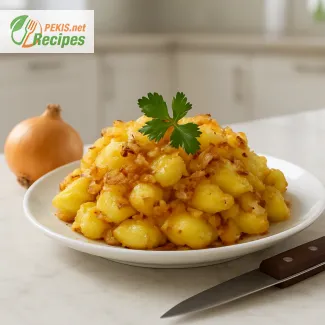
Discover the Historical Flavor of Grenadier March
A rustic European comfort dish made with simple, nourishing ingredients
The Grenadier March, also known in some regions as Grenadiermarsch, is a humble yet deeply nostalgic dish that has its roots in Central European military cuisine. Once a staple in the Austro-Hungarian army's field kitchens, this dish represents the ingenuity of creating satisfying meals with minimal resources. Its simple combination of potatoes, pasta, onions, and occasionally paprika or bacon, captures the essence of post-war and peasant-style cooking that focused on hearty sustenance and accessible ingredients.
Today, Grenadier March is celebrated across Slovenia, Austria, Hungary, Czechia, and parts of Germany as a classic comfort food that connects generations through flavor and tradition. In Slovenia, particularly in the Zasavje region, it has become a symbol of local culinary heritage—often served as a weekday meal or during traditional gatherings.
The name "Grenadier March" is said to evoke the image of soldiers on the move, sustained by this energy-rich meal that combines the starch of potatoes with the carbohydrates of pasta, offering a surprisingly delicious texture contrast. When sautéed in onion-infused fat and seasoned with just the right amount of salt, pepper, and sometimes smoked paprika, it transforms into something much more than the sum of its parts.
While some recipes add a touch of smoked sausage, bits of cured bacon, or even a sprinkle of grated cheese, the most authentic versions stick to the basics. What makes this dish stand out isn't complexity, but its ability to evoke warmth, satiety, and cultural memory in every bite.
Its popularity has seen a resurgence in recent years as home cooks embrace traditional, budget-friendly meals that are both comforting and flavorful. Grenadier March fits perfectly into the modern trend of one-pan, no-fuss recipes that are easy to prepare yet deeply satisfying. For busy families or those looking to stretch ingredients creatively, this dish provides a perfect balance of simplicity and substance.
Regional roots and cultural relevance
From Austro-Hungarian field rations to family dinner tables
The origins of Grenadier March go back to the 19th century, where it was commonly prepared in military camps and barracks as a practical solution to feed large groups. Combining cooked potatoes and leftover pasta was both economical and efficient. This meal not only nourished soldiers on the march but also allowed cooks to avoid food waste—long before sustainability became a trend.
In Slovenia, especially in Zasavje, the dish has evolved into a regional specialty. Its name is still associated with military history, but it’s now more likely to be served at family gatherings, school lunches, or community feasts. Generations of Slovenians have grown up with the comforting aroma of fried onions, potatoes, and pasta filling their homes.
Grenadier March is also widely known in Austria, where it often appears in traditional cookbooks. The Austrian version may sometimes include sauerkraut, chives, or parsley for extra aroma, while the Hungarian adaptation might introduce paprika for a mild kick. Despite these variations, the foundation remains the same—boiled potatoes and noodles sautéed together until golden.
In Czechia, the dish is affectionately called granadýrský pochod and is known for its robust, peasant-style appeal. Served mostly in countryside homes or at rustic pubs, it’s a dish that thrives on nostalgia and familiarity.
A dish made for modern kitchens
Simple ingredients, powerful flavors
What makes Grenadier March especially appealing to modern home cooks is its accessibility. The ingredients are often already in your pantry: a few potatoes, leftover pasta, an onion, some oil, and basic spices. That’s all it takes to create a meal that’s satisfying, affordable, and wholesome.
The method of preparation also contributes to its charm—no special equipment, no long cooking times, and no complicated techniques. It’s perfect for beginner cooks, students, or anyone seeking a quick lunch or dinner that still feels like a proper meal.
Adding a touch of butter, fresh herbs, or a poached egg can elevate it to an even more fulfilling experience. But even without embellishments, its rich, toasty flavor—thanks to the caramelized onions and golden potato edges—is what keeps people coming back.
In a time when many are turning to traditional recipes for both flavor and frugality, the Grenadier March stands tall as a culinary time capsule, offering a window into the resilience and creativity of past generations.
Whether you grew up eating this dish or are discovering it for the first time, it promises an experience that is hearty, genuine, and full of history.
- Boil the potatoes: Peel and cut the potatoes into small cubes. Boil them in lightly salted water for 12–15 minutes until tender but not falling apart. Drain and set aside.
- Cook the pasta: In a separate pot, cook the pasta in salted boiling water according to package instructions (typically 7–9 minutes). Drain, rinse under cold water, and let cool.
- Sauté the onions: Peel and finely slice the onions. In a large skillet or frying pan, heat the sunflower oil over medium heat. Add the onions and sauté for about 8–10 minutes, stirring frequently, until soft and golden brown.
- (Optional) Fry the bacon: If using bacon, add it to the onions once they start to caramelize and cook for another 4–5 minutes until the bacon becomes crispy.
- Combine the ingredients: Add the boiled potatoes to the pan with onions (and bacon if using). Stir gently for 3–4 minutes to brown the edges.
- Add the pasta: Fold in the cooked pasta and mix everything together carefully, ensuring the ingredients are evenly combined and slightly toasted.
- Season: Add salt, black pepper, and smoked paprika to taste. Mix well and sauté for an additional 2–3 minutes.
- Serve: Sprinkle with chopped parsley if desired and serve warm as a main dish.
Enhancing the Grenadier March with Modern Twists and Traditional Wisdom
Small changes that elevate taste, texture, and nutrition without compromising authenticity
Grenadier March may be a dish born out of necessity, but its honest flavors and simple ingredients offer an ideal base for creative reinvention. Whether you're looking to enhance the dish for modern palates or adapt it to meet dietary goals, there are numerous ways to elevate its flavor, texture, and presentation while still honoring its Central European roots.
Use of fresh, high-quality ingredients makes all the difference
At its core, this dish relies on potatoes, pasta, onions, and fat. The key to elevating its flavor lies in choosing the best possible ingredients. Waxy potatoes such as Charlotte or Nicola hold their shape better and offer a creamier bite compared to floury types. Selecting bronze-cut pasta brings a rough surface that better adheres to the fried onion and fat, intensifying the richness.
For an added dimension of taste, consider sautéing the onions in a combination of sunflower oil and butter. This blend brings out a rounder, nuttier depth that pure oil can’t offer. If you're using bacon, sourcing smoked pancetta or local farm bacon adds not only texture but a complex umami profile that transforms the dish from humble to luxurious.
Substitutions that improve nutritional value
If you're aiming for a healthier version, replace standard pasta with whole wheat, spelt, or chickpea pasta. These alternatives boost fiber and protein content while adding a mild nuttiness. For frying, opt for cold-pressed rapeseed oil or extra virgin olive oil, which contain healthier fats and bring subtle aromas to the final flavor.
Introducing vegetables like sautéed cabbage, leeks, or bell peppers adds volume, color, and vitamins without altering the character of the dish. A few spoonfuls of sauerkraut stirred in during the last minutes of cooking lend brightness and acidity, cutting through the richness and offering probiotic benefits.
Adding a poached egg on top or grating a bit of aged cheese like Parmigiano-Reggiano enhances the texture and visual appeal. These additions also turn the dish into a complete and satisfying meal with higher protein and calcium levels.
How to bring out the best in flavor and texture
The art of caramelizing onions
One of the defining flavors of Grenadier March comes from properly browned onions. This process should never be rushed. Use medium heat and stir frequently for at least 10 minutes until the onions turn a rich golden color. Adding a pinch of sugar can speed up caramelization and deepen the sweetness, but it must be done sparingly to avoid overpowering the dish.
Toasting the pasta and potatoes for golden crisp
After combining all ingredients, allow the pasta and potatoes to sit undisturbed in the pan for a minute or two. This creates a crisp golden layer at the bottom, which adds a delightful texture contrast. Repeat this technique in batches to prevent steaming.
Common mistakes to avoid when preparing Grenadier March
A frequent issue is overcooking the potatoes, which leads to a mushy texture that breaks apart when mixed with pasta. To prevent this, always boil potatoes until just tender and cool them slightly before sautéing.
Another common problem is uneven seasoning. The dish needs proper salting at every stage—while boiling pasta, boiling potatoes, and especially during final seasoning. Using low-sodium salt or herb-infused salt can create a more balanced flavor while allowing for sodium control.
Overcrowding the pan is also a critical mistake. This traps steam and prevents the desired browning. Cook in batches if necessary, especially when making larger portions.
Why homemade Grenadier March tastes better
The store-bought or cafeteria versions of this dish often lack the careful preparation and ingredient integrity that come with homemade cooking. Preparing it from scratch allows you to balance textures, adjust seasonings, and use locally sourced ingredients, which results in a dish that’s richer in both flavor and cultural significance.
When made at home, it’s easier to adjust the dish to personal taste—whether that means making it vegetarian, gluten-free, or spiced with paprika or garlic. It also encourages a connection with culinary heritage, especially when made as a family tradition or passed-down recipe.
Creative additions and modern adaptations
To make Grenadier March stand out on the table or appeal to a more diverse group, try these additions:
- Fresh herbs such as dill, thyme, or tarragon for aromatic complexity
- A squeeze of lemon juice or apple cider vinegar to brighten the dish
- A drizzle of smoked chili oil for a subtle spicy edge
- Roasted garlic puree mixed in at the end for an extra savory finish
Each of these adds depth and freshness while keeping the identity of the dish intact.
Whether you're sticking to tradition or reimagining this classic, Grenadier March offers a generous canvas to explore flavor, sustainability, and comfort all at once.
Allergens present in the recipe:
- Gluten (wheat pasta)
- Optional allergen: Pork (if bacon is added)
Suggestions to replace allergens and gluten:
- Use gluten-free pasta made from rice, corn, or legumes to make the dish suitable for people with celiac disease.
- To replace bacon, use smoked tofu or tempeh for a similar umami flavor without pork or meat.
Vitamins and minerals per serving (approximate):
- Vitamin B6: 0.5 mg – supports brain health and metabolism
- Vitamin C: 22 mg – enhances immune function and antioxidant protection
- Iron: 2.1 mg – helps with oxygen transport in the blood
- Magnesium: 48 mg – essential for muscle and nerve function
- Potassium: 700 mg – supports heart and muscle function
- Phosphorus: 160 mg – important for bone health and energy metabolism
- Folate: 60 mcg – crucial for cell growth and red blood cell formation
Antioxidants per serving (approximate):
- Flavonoids (from onions): 10–15 mg – may reduce inflammation and support heart health
- Carotenoids (from paprika): 2–3 mg – support eye health and immune function
- Phenolic acids (from potatoes): 20 mg – contribute to cellular protection and oxidative stress reduction





